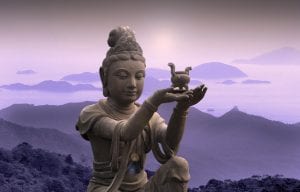Buddhist Funeral Service Rituals

Note: Buddhist funeral customs vary between traditions or “schools” and even within schools. They may also vary depending on the country—for example, Zen in Taiwan and Zen in Japan are different. The following information is general and applies to many or most Buddhist traditions. If you have specific questions related to Buddhist funeral customs for a particular sect, we recommend consulting with your spiritual advisor.
Funeral customs vary among the different Buddhist sects and from one country to another. Some funerals are very ritualistic and traditional, while others are quite simple, solemn, and dignified. Rather than spending lavishly on expensive but perhaps meaningless traditions and rituals, the family and friends may consider donating to a worthy cause and transferring the merit to the deceased.
Peace and serenity are hallmarks of a Buddhist funeral. An altar is set up to display the deceased’s portrait, along with offerings of candles, incense, flowers, and fruit. An image of the Buddha is placed beside or in front of the altar.
Buddhist Funeral Rites
According to Buddhist funeral customs, a service may be presided over by monks, who will deliver a sermon and perform Buddhist rites. If a monk is unavailable, others may conduct the service. Rituals that transfer merit to the deceased may be performed by family or other mourners, such as offering cloth to the presiding monk on the deceased’s behalf, pouring water from a vessel into an overflowing cup, preaching, and giving offerings or almsgiving.
At a traditional Buddhist funeral, the family typically wears white or covers their clothing with a traditional white cloth, accompanied by a headband or armband. Mourners may also:
- Walk with sticks to symbolize that grief has left them the need for support
- Chant or sing appropriate sutras (prayers)
- Bring offerings of flowers and fruit
- Burn incense to sweeten the air
- Ring gongs or bells
Although Buddhists understand that death is not an end, only a transition from one form to another, it is acceptable to show grief. In doing so, friends and family members acknowledge the loss of their loved one. The focus, however, should be on understanding the transiency of life, thinking about one’s mortality as an impetus to make life meaningful, and performing good deeds on behalf of the deceased person.
The deceased may be cremated or buried, although cremation is the traditional method. Monks, if present, will perform the last rites before the casket is sealed. Family members may assist in lifting the casket as a final act of respect, while others attending may observe a moment of silence in remembrance. During the funeral procession, family members may walk behind the hearse; all attendees should send good thoughts to the family and contemplate the impermanence of life.
The Buddha said,
Life is a journey.
Death is a return to earth.
The universe is like an inn.
The passing years are like dust.</em>
Regard this phantom world
As a star at dawn, a bubble in a stream,
A flash of lightning in a summer cloud,
A flickering lamp – a phantom – and a dream.*
*Vairacchedika 32.
| Buddhist Funeral Customs Quick Reference Guide | |
|---|---|
| Length of Service | 45 – 75 minutes |
| Flowers? | Yes – white or yellow. (See our Sympathy Flowers) |
| Food? | No |
| Dress Code? (Men/Women) | Dark & Casual |
| Recording Devices? | No |
| Source of Readings? | Sutras |
| Open Casket? | Always |
| Return to Work? (Days) | No specific time |
| No. of Days to Mourn? | 90 |
| Embalming? | Accepted |
| Cremation? | Preferred |
| Body/Organ Donation? | Valued as an act of compassion, but up to the individual’s preference. |
A Buddhist View of Death
Buddhism: A Snapshot
- A philosophy and a way of life
- Practiced in Eastern civilization for more than 2500 years
- Fourth-largest religion in the world, with almost 400 million adherents
- Does not promote worship of a deity
- Promotes enlightenment and moral virtue
The Buddha, Siddhartha Gautama, did not claim to be a god but rather an enlightened man. When Buddhists bow or offer flowers or incense to a statue of the Buddha, it is to express thanks for his teachings and to feel that they are in the Buddha’s living presence.
Basic Buddhist Beliefs
- Everything changes, nothing is permanent, and suffering is inevitable.
- Buddhist teachings lead one to true happiness, enlightenment, and freedom from suffering.
- Death is a natural part of life.
- Both wisdom and compassion should be developed.
- Death does not extinguish a spirit. Instead, it transfers to another life in one of six separate planes (three fortunate and three unfortunate).
- A person’s actions during his lifetime result in karma that determines in what form his spirit will be reborn–as a human, an animal, or various forms of spirits. These spirits include angels, demons, gods, and ghosts.
What is karma?
The Buddha taught that every action causes an effect, whether good, bad, or neutral, resulting in the accumulation of karma that will shape the person’s future—in what form he will be reborn and whether he will suffer or be happy, experience positive or negative moments.
Buddhists do not believe in an eternal soul that goes to meet God in the Christian sense, or one that is continually reincarnated in the Hindu sense; rather, the concept of rebirth (or Buddhist reincarnation) has been described as lighting a candle with the flame from another candle.
What is nirvana?
The literal meaning of the word nirvana is “to extinguish.” A Buddhist’s hope is to be reborn into the human world, from which nirvana may eventually be achieved. A Buddhist is liberated from the cycle of rebirth only by reaching nirvana (the cessation of craving, ignorance, and suffering).
Some believe nirvana to be a heavenly paradise, while others believe it to be nothingness; the Buddha did not make this clear in his teachings. Achieve nirvana through great effort over many lifetimes. To reach nirvana, one must purify the your soul by practicing right understanding, right thought, right speech, right mindfulness, right livelihood, right action, and right concentration.
How to Help a Buddhist Who Is Nearing Death
It is more important to Buddhists to care for the lives of the people all around them than to prolong or extend life when death is imminent.
Death for a Buddhist should be a smooth, peaceful process—death is natural and inevitable. The person who is dying should be in a virtuous state of mind in the moments before death, because a better rebirth may result.
Those final moments are the Buddhist’s springboard into the next life. Some will want to lie on their right side, emulating the posture of the Reclining Buddha, to contemplate the Buddha and his passing better. Having an image of the Buddha close by can also be comforting and conducive to good and peaceful thoughts.
Family and friends should reassure the person of the good deeds they have done and the good karma they have accumulated. A person accumulates karmic forces throughout their lifetime. Those forces are activated on death and determine whether the next life will be auspicious. Those who are present during the person’s last hours can also perform good deeds or give donations in the dying person’s name and share the merit with him. If you are a practicing Buddhist, you can radiate metta (loving kindness) to the person who is dying to help ease their suffering and boost their confidence. Remain calm; do not weep or openly grieve in front of the dying person. You do not have to ignore or deny your grief; just keep your composure as you help your loved one face death with serenity.
How do Buddhists grieve?
The Buddhist concept of death as a natural part of life, with an inevitable rebirth, may lead those outside the faith to believe that grief is minimized in Buddhist traditions. This is not the case. Grief is a universal emotion, and those left behind must learn to adjust to a new life without their loved ones.
Buddhists are, however, encouraged to remain calm and peaceful in the presence of one who is dying.
There is a story told of a woman who brought her dead child to Buddha and begged him to bring her child back to life. Buddha asked the woman to get a mustard seed from a house where no one had ever died. Only then would he grant her wish. She, of course, could not find a household saved from the pain of death, and the universality of dying then struck her.
Resources:
www.buddhanet.net/pdf_file/buddhist_funeral.pdf
www.pbs.org/edens/thailand/buddhism.htm
www.buddhanet.net/e-learning/5minbud.htm
/www.youtube.com/watch?v=9_FPZeXKpNU
www.youtube.com/watch?v=iWIj_hdLwgc

